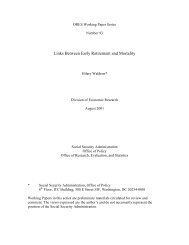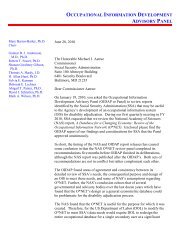for the test of equality of means between the benefitsreceived by those claiming at age 65 in 1994 and all theother ages and time periods. Notice that in most caseseven if the benefit levels seem rather close, the levelsare significantly different from those received by theage-65 claimers of 1994. In the table we also see thatthe major change in the post-2000 period in the levelof benefits received by those claiming after age 65 ishighly significant. Furthermore, the level of benefitsgoes from being in a number of cases not significantlydifferent from the 1994 figure in the pre-2000 period, tosignificantly higher in 2000, to significantly lower in the2001–2004 period. This provides even clearer evidenceof the changes resulting from abolishing the earningstest, even in the presence of the more generous DRC.Table 6 provides a slightly different presentationof the test of statistical significance of differencesin means. In this case instead of using the level ofbenefits of those who claimed at age 65 in 1994, weuse the age-specific benefit levels as of 1994 to capturethe variation over time and by age in the level ofbenefits. The results are even more striking and showa clear divergence in the benefit levels over time forthose between ages 62 and 65 and those aged 66 orolder. Although the former group’s level of benefits areon the rise with increasingly statistically significantresults, the benefit level for late claimers is quite theopposite, and they are receiving much lower benefitsover time. The breaking point is the year 2000, suggestingin even more striking fashion the likely effectof the removal of the earnings test in the compositionof those claiming benefits after age 65 and the effectof the increase in the FRA in the composition of thoseclaiming early.Table 5.t-statistics of monthly <strong>Social</strong> <strong>Security</strong> retirement benefits: Benefit levels of those who claimed at age 65in 1994 used as comparisonAge 1994 1995 1996 1997 1998 1999 2000 2001 2002 2003 200462 -13.4805 -18.8968 -19.0375 -17.0784 -14.8081 -4.7205 -5.1620 -0.1537 5.7532 7.3185 -0.652163 -10.7386 -7.5375 -10.1821 -10.6993 -8.8523 -8.7318 -3.5480 -3.6254 -1.5533 1.8736 -2.730364 -3.5988 -3.5065 -2.9701 -5.2823 -5.9061 -3.5680 -2.6853 1.7147 3.3087 3.0444 2.856365 a -1.0169 -1.0494 -0.3811 -4.1109 -4.4248 -2.2722 1.7050 7.3361 9.1248 3.970366 1.6634 -1.8287 -0.0406 -1.5536 0.2626 0.8813 4.7070 -5.1937 -6.8857 -3.8777 -0.264467 -1.4849 -1.1258 -0.6589 -1.6699 -2.8487 0.3316 4.5750 -6.4220 -4.4015 -5.3363 -3.782768 -1.7849 -2.6873 -2.6178 -2.9188 -2.7914 -1.1290 2.3995 -5.0251 -7.3427 -7.5304 -6.926669 0.6060 0.5722 -2.7263 -2.5275 -2.8545 -1.0505 0.3075 -5.0385 -5.5857 -8.7639 -5.0799SOURCE: Authors' calculations using the OASDI public-use microdata file, 2004.NOTE: The shaded cells represent significance at the 5 percent level or higher.a. The corresponding cell from Table 3 is used as the comparison to test the equality of means with the rest of the cells in Table 3.Table 6.t-statistics of monthly <strong>Social</strong> <strong>Security</strong> retirement benefits: Age-specific benefit levels as of 1994 used ascomparisonAge 1994 1995 1996 1997 1998 1999 2000 2001 2002 2003 200462 a -5.0854 -4.7262 -3.0317 -0.8293 8.7489 8.2168 12.7966 17.8826 19.6706 12.692963 a 3.1878 0.3795 0.2090 1.8700 1.7511 6.8118 6.6375 8.2948 11.3359 6.905564 a -0.0142 0.4258 -1.9550 -2.3494 0.0167 0.8833 5.1546 6.6978 6.2461 6.077665 a -1.0169 -1.0494 -0.3811 -4.1109 -4.4248 -2.2722 1.7050 7.3361 9.1248 3.970366 a -3.4769 -2.0748 -3.2545 -1.4839 -1.1444 1.8398 -6.2997 -8.1969 -5.1407 -4.156867 a 0.2529 1.1169 -0.0669 -1.1116 2.3824 7.3587 -5.0108 -3.2678 -4.1064 -2.685468 a -1.0077 -0.4352 -0.6420 -0.5713 1.3613 5.8301 -3.1657 -5.3119 -5.5411 -4.875369 a -0.0380 -3.4901 -3.1597 -3.5718 -1.7969 -0.6406 -5.7073 -6.2444 -9.4584 -5.6763SOURCE: Authors' calculations using the OASDI public-use microdata file, 2004.NOTE: The shaded cells represent significance at the 5 percent level or higher. Bold type is used to emphasize the differences by agegroup.a. The corresponding cells from Table 3 are used as the comparison to test the equality of means with the rest of the cells, by age,in Table 3.86 <strong>Social</strong> <strong>Security</strong> Bulletin • Vol. 69 • No. 3 • 2009
Comparisons by SexTables 7 through 9 break down the benefit claiminginformation by sex, providing a sample of what canbe gained by controlling for some of the heterogeneityimplicit in the previous tables. 28 Table 7 presentsthe proportion of individuals claiming benefits by agefor men and women. We observe that women claim atlower ages than men, with a larger proportion of themclaiming at age 62, and a smaller proportion claimingat age 65. As shown for both men and women, theproportion of individuals suddenly claiming at age 66increases by several percentage points from a verylow level―from 1.0 percent to 7.6 percent for men andfrom 1.3 percent to 6.5 percent for women, althoughthe aggregate data shows no such trend during the2003–2004 period. This is probably in part the resultof a combination of the complementarity of leisure forhusbands and wives, coupled with the fact that menare, on average, a few years older than their wives (seeBlau (1997 and 1998), Blundell and others (2001), andBenítez-Silva and Dwyer (2006)). We also see that thelarge shift in the proportions of claimants in 2000 wasmuch more pronounced for men, but in both cases theproportions seem to have reverted to pre-2000 figuresby 2004, with an additional effect―the proportions ofthose claiming after age 65 have decreased for bothsubsamples. The exception to this occurred in 2004(and will possibly continue into the future), and asexplained for Table 1, this is due to the way the microdatarecords (assigning claimers to age 66) individualswho file for benefits exactly when they reach the FRA(now higher).Table 8 provides the retirement benefit mean levelsthat have been actuarially and inflation-adjusted formale and female workers, which we also show inChart 3. Notice the large differences in benefit levels,with men receiving at most ages and in most yearsmuch higher benefits than women and with a muchhigher variance across ages. This comes as no surprisegiven what we know about the labor force participationand earnings of these groups during the pastdecades, but it is still worth noting. Again we also seeTable 7.Proportion of new claimants of <strong>Social</strong> <strong>Security</strong> retirement benefits, by sex and age, 1994–2004Age 1994 1995 1996 1997 1998 1999 2000 2001 2002 2003 200462 0.489 0.480 0.509 0.500 0.491 0.473 0.414 0.453 0.460 0.465 0.47863 0.162 0.170 0.150 0.158 0.163 0.152 0.137 0.163 0.160 0.148 0.14264 0.081 0.072 0.072 0.066 0.071 0.072 0.061 0.075 0.073 0.073 0.07265 0.207 0.215 0.201 0.208 0.207 0.212 0.248 0.273 0.275 0.282 0.21966 0.022 0.024 0.025 0.025 0.024 0.033 0.054 0.009 0.010 0.010 0.07667 0.008 0.010 0.013 0.015 0.013 0.018 0.031 0.007 0.005 0.006 0.00468 0.008 0.008 0.009 0.008 0.007 0.012 0.021 0.004 0.003 0.005 0.00269 0.007 0.004 0.007 0.006 0.007 0.009 0.013 0.004 0.004 0.003 0.001Total number 5,766 5,911 6,001 6,073 6,344 6,970 8,169 7,195 7,266 7,404 7,794MenWomen62 0.562 0.548 0.513 0.538 0.548 0.537 0.497 0.532 0.510 0.510 0.51763 0.160 0.161 0.135 0.143 0.140 0.142 0.134 0.151 0.151 0.142 0.14464 0.066 0.065 0.055 0.060 0.064 0.062 0.058 0.061 0.066 0.064 0.06165 0.158 0.173 0.149 0.162 0.163 0.178 0.203 0.205 0.216 0.223 0.18166 0.015 0.015 0.020 0.017 0.018 0.021 0.029 0.008 0.012 0.013 0.06567 0.012 0.010 0.014 0.010 0.014 0.015 0.022 0.006 0.005 0.007 0.00568 0.007 0.005 0.009 0.009 0.010 0.009 0.014 0.006 0.006 0.005 0.00569 0.005 0.007 0.011 0.009 0.009 0.007 0.012 0.007 0.000 0.000 0.004Total number 4,934 5,115 5,675 5,545 5,711 6,079 6,806 6,410 6,442 6,695 7,057SOURCE: OASDI public-use microdata file, 2004.NOTE: In the data, there is no way to separate disability converters from old-age claimants at age 65. What we have done is to assume aproportion of <strong>Social</strong> <strong>Security</strong> claimants from age-65 samples each year as disability converters. The proportions used are calculatedaccording to the Supplement .<strong>Social</strong> <strong>Security</strong> Bulletin • Vol. 69 • No. 3 • 2009 87
- Page 1 and 2:
Social SecuritySocial SecurityBulle
- Page 3:
Social SecurityBulletin Vol. 69, No
- Page 6 and 7:
Perspectives77 An Empirical Study o
- Page 8 and 9:
Selected Abbreviations—continuedM
- Page 10:
within the next few years (Aglira 2
- Page 14 and 15:
coverage varies significantly by ra
- Page 16 and 17:
non-Hispanic white, and college edu
- Page 18 and 19:
same groups (Table 6). For the last
- Page 20 and 21:
from DB to DC pensions is accelerat
- Page 22 and 23:
Table 8.Percent of individuals who
- Page 24 and 25:
not necessarily the largest gains a
- Page 26 and 27:
shoring-up DB plans before those pl
- Page 28 and 29:
Table B-1.Percent change in mean pe
- Page 30 and 31:
Table B-3.Percent of individuals wh
- Page 32 and 33:
ReferencesAaronson, Stephanie, and
- Page 35 and 36:
Social Security Administration’s
- Page 37:
Chart 1.Historical expansion of Soc
- Page 40 and 41:
self-employment information for the
- Page 42 and 43: (Cronin 1985). The final earnings r
- Page 44 and 45: prior to 1950, first year of earnin
- Page 46 and 47: average indexed monthly earnings (A
- Page 48 and 49: 13For an explanation of how the sel
- Page 50 and 51: Kopczuk, Emmanuel Saez, and Jae Son
- Page 53 and 54: Occupations of SSI Recipients Who W
- Page 55 and 56: on the differences between the occu
- Page 57 and 58: prediction models. Table A-1 lists
- Page 59 and 60: Occupational Distributions of theEm
- Page 61 and 62: similar, only 4 percent of the popu
- Page 63 and 64: Table 5.Estimated occupational dist
- Page 65 and 66: Table 7.Predicted Herfindahl-Hirsch
- Page 67 and 68: Table 9.Estimated occupational dist
- Page 69 and 70: Table 11.Average annual wages of wo
- Page 71 and 72: Table A-2.Means and standard errors
- Page 73 and 74: Table A-3.Coefficients and standard
- Page 75 and 76: Table A-3.Coefficients and standard
- Page 77 and 78: Table A-3.Coefficients and standard
- Page 79 and 80: management, professional, and relat
- Page 81: Stapleton, David C., Nanette Goodma
- Page 84 and 85: Selected Abbreviations—continuedO
- Page 86 and 87: The 1983 Amendments to the Social S
- Page 88 and 89: Chart 1.Proportion of new claimants
- Page 90 and 91: Table 4.The evolution of the ARF an
- Page 94 and 95: Table 8.Average monthly Social Secu
- Page 96 and 97: in the chart, especially for men, t
- Page 98 and 99: 6This is a very important character
- Page 100 and 101: Benítez-Silva, Hugo, Berna Demiral
- Page 103 and 104: OASDI and SSI Snapshot andSSI Month
- Page 105 and 106: Monthly Statistical Snapshot, Augus
- Page 107 and 108: Table 2.Recipients, by eligibility
- Page 109 and 110: SSI Federally Administered Payments
- Page 111 and 112: Table 7.Average monthly payment, by
- Page 113: Awards of SSI Federally Administere
- Page 116 and 117: Copyright—Authors are responsible
- Page 119 and 120: Program Highlights, 2009Old-Age, Su








